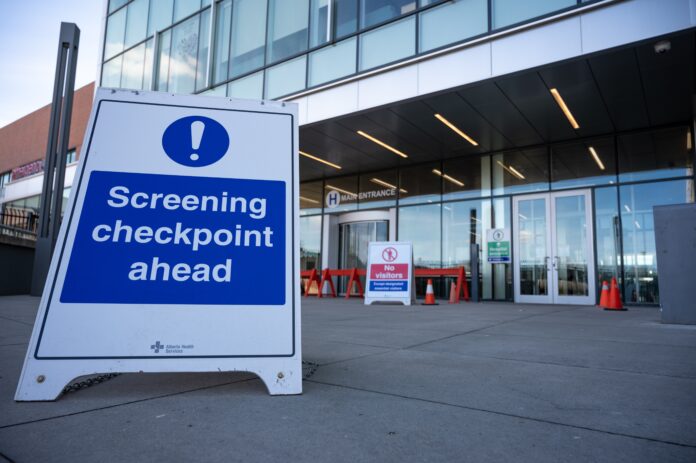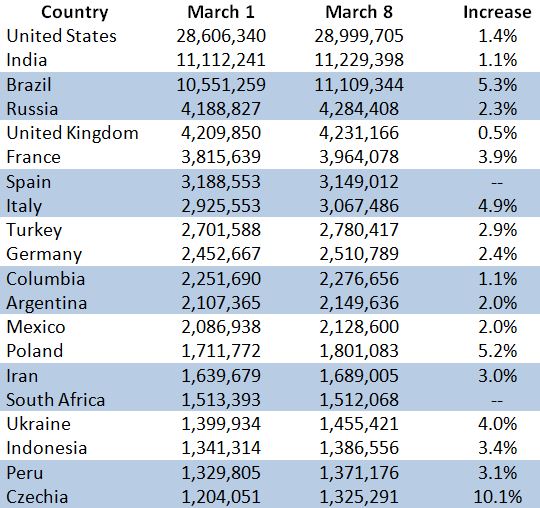
As cases of COVID-19 continue to slow in the U.S. with hospitalizations down about 70 percent from their peak, cases in Europe increased 9 percent over the past week. The big question is whether a similar increase lies in the future for the United States.
According to the WHO, its new variations of the virus that are causing the European increase, as reported in this article from the Associated Press:
The variant first found in the U.K. is spreading significantly in 27 European countries monitored by WHO and is dominant in at least 10 countries: Britain, Denmark, Italy, Ireland, Germany, France, the Netherlands, Israel, Spain and Portugal.
It is up to 50% more transmissible than the virus that surged last spring and again in the fall, making it more adept at thwarting measures that were previously effective, WHO experts warned. Scientists have concluded that it is also more deadly.
In reality, the difference in numbers may related to the greater success with vaccination in the U.S. The European Union, as we have reported before, was slow to order vaccines and is lagging the U.S. in both vaccine availability and the number of people being vaccinated per day.
U.S. Recovery
The increased spread in Europe means international travel may not return even if we have a “near normal” summer in the U.S. At worst, summer could see cases climb again, much as they did in July 2020, resulting in new calls for lockdowns. But if vaccination (see below) proceeds as planned, lockdowns may become a thing of the past, at least int he U.S.
In the past 24 hours, the U.S. reported 40,336 new cases and 682 deaths. Hospitalizations due to COVID-19 were down to 40,212. A lagging indicator, hospitalizations have dropped 29 percent over the past 2 weeks, according to the New York Times.
Approximately 17 percent of new cases in the U.S. are from New York while 10 percent are from Florida and 7 percent from Texas. Approximately 12 percent of all hospitalizations are in New York.
Vaccination Promises vs. Reality
President Biden said last week that there will be enough vaccines for everyone who wants one to be vaccinated by the end of May. Notice how he did not guarantee everyone would be vaccinated, only that there would be sufficient doses. It seems getting vaccines into arms is harder than producing the vaccine.
If vaccination in the U.S. continues at the current rate of just over 2 million people per day, the U.S. could have more than 100 million people fully vaccinated and another 60 million with a single dose by the end of may. That’s about half the country. (Notice that we said could. This is a projection; the real number might be higher or lower. One thing we have seen during the past year of COVID-19 is that predictions based on current trends are often wrong.)
If we see that level of vaccination, and if the vaccine is as effective against new variants, it could result is a significant decrease in cases over the summer.
It will be interesting to see if the current Spring Break gatherings in Florida and elsewhere result in an uptick in cases in two or three weeks or hospitalizations in a month. If there is no upward bump, then summer may well see a return to normalcy, followed by everyone going back to in-person school in the fall.
The Superbowl was a month ago Sunday and there has been no visible uptick in U.S. cases because of parties and other potential “super spreader” events related to the big game. Whether spring break will be a similar non-event remains to be seen.
Global Numbers
Here’s a look at week-over-week total cases in the 20 countries with the most COVID-19 cases:

In the past week, the number of cases in Russia exceeded those in the UK. And Russia moved into fourth place on the top 20 list. There were no other changes in ranking on the list.
The biggest news appears at the top of the chart where the U.S. is now reporting an increase of 1.38 and the UK is down to 0.5 percent. Iran and Peru also dropped a percent. Brazil, Italy, Turkey, Poland, Ukraine, and Czechia saw increases. (The apparent decreases in Spain and South Africa are the result of data or reporting anomalies.)
For more perspective, you can view data from a week ago or from the pandemic’s peak in January when cases in the U.S. increased 9 percent in a week.






